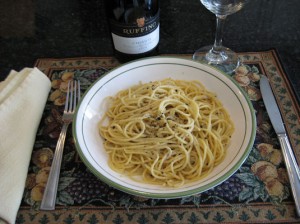I have an attraction for recipes that, when executed correctly, are basically foolproof. In that context I call attention to a variation of a widely consumed Roman pasta dish called “Cacio e Pepe,” a name that refers to the cheese used to flavor the noodles (cacio) and the coarsely ground black pepper that really defines the dish (pepe). I discovered that the word ‘cacio’ (pronounced kah-cho) in Italian is more or less synonymous with “formaggio” or “cheese” but seems to be used mainly to describe sheep’s milk products generically.
The cheese in the spotlight is the well-known Pecorino Romano, a tangy, salty hard grating cheese readily available in most supermarkets. However my preference is for the less well known version called “Cacio di Roma,” a semi-soft cheese slighly milder and slightly less salty than the Pecorino. The Cacio di Roma renders the dish more faithfully Roman in character. So say the Senatus PopolusQue Romanus, SPQR – the Senate and People of Rome.
I became a worshipper of this pasta gem at a chance encounter with the a sidewalk restaurant on Rome’s Via Veneto called “Cafe Strega,” or the “witch’s cafe.” On the menu one will find the selection called “Tagliolini Cacio e Pepe.” The price only 10 Euros, 13 dollars US. Since that first visit I have gone back a second and third time in the recent past.
The Cafe Strega recipe uses the more popular Pecorino Romano cheese and not the Cacio di Roma. Consulting the Italian websites I actually found one recipe that called for Pecorino Romano “or other sheep’s milk cheese.” Having since made it with both kinds I maintain that the Cacio di Roma is the better choice, if of course you can get your hands on some.
Let’s look into a few details regarding the Cafe Strega’s exquisite pasta dish.
First, what the heck are ‘tagliolini’ and how do you pronounce the word?
Tagliolini are thin foot-long egg noodles similar to fettuccine but more square cut in cross section. Pronunciation is “Tal – Yo – Leeny.” The “g” is silent. Tagliolini are available in the U.S. but could appear under a variety of alternate names, such as tagliatelle, tonnarelli or taglierini. The pasta Ph.D’s in Italy would argue that they are not the same animal and I believe them, however in real life trying to distinguish them whether by taste or appearance is a pointless exercise. To make matters worse there is an identical- looking product native to the province of Abbruzzi called “spagetti alla chitarra,” which will be the subject of another discussion.
Of course the recipe works with any egg pasta noodle as you might expect (except Muellers and Pennsylvania Dutch). Cut pasta such as ziti or rigatoni, as well as spaghetti and linguine, are not egg-based and so the result is quite different and to me less appealing. Needless to say home-made egg noodles stand at the top of the heap!
And now a word about the “pepe” part of the picture. My contention is that coarsely-ground fresh black pepper is the key ingredient, more so than the choice of cheese. Finely ground pepper, or the commercial stuff in the red and white can that has been hanging around in your spice cabinet for the past 14 years, will ruin the dish. Ideally the peppercorns should be hand-ground with a mortar and pestle or crushed between two sheets of plastic wrap with a small cast iron skillet (makes a big mess of course). You could also try loosening the cap of your peppermill slightly before turning to get a coarse grind.
Lastly we have to deal with the problem of keeping the pasta from drying out after the cheese and pepper have been added. This is a constant headache for me and the solution involves mostly guesswork. Basically it is important to save a cup or two of the pasta water before draining the noodles so that once the cheese and pepper are incorporated you can add water in small amounts to maintain consistency. Unfortunately the catch-22 is that the pasta will continue to absorb the water, making it essential to serve the dish immediately after cooking and mixing. It does not keep well and definitely cannot be made ahead or held in the refrigerator as a leftover, unless, like me, you eat pasta in any condition.
 Cacio e Pepe – The Recipe
Cacio e Pepe – The Recipe
To serve 4:
- 1 lb. tagliolini (or tagliarelle or taglierini or tonnarelli or spaghetti alla chitarra, or, what the heck, fettuccine)
- 1 1/2 cups finely shredded Cacio di Roma (or Pecorino Romano or both, but NOT parmesan)
- 2-3 tablespoons coarsely ground black pepper
Cook pasta according to package directions in generously salted water (4-5 quarts) at full boil. After 5 minutes taste for “al dente.” Before draining reserve 1 cup water. Drain pasta and turn into a warmed serving bowl. Gradually add cheese and ground pepper mixing constantly. Add reserved pasta water to maintain moist consistency. Serve immediately if not sooner.
